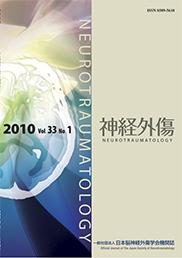33 巻, 1 号
神経外傷
選択された号の論文の21件中1~21を表示しています
- |<
- <
- 1
- >
- >|
特別寄稿
-
原稿種別: 特別寄稿
2010 年33 巻1 号 p. 1-6
発行日: 2010/12/27
公開日: 2021/04/20
PDF形式でダウンロード (2668K) -
原稿種別: 特別寄稿
2010 年33 巻1 号 p. 7-11
発行日: 2010/12/27
公開日: 2021/04/20
PDF形式でダウンロード (2541K)
原著
-
原稿種別: 研究論文
2010 年33 巻1 号 p. 12-18
発行日: 2010/12/27
公開日: 2021/04/20
PDF形式でダウンロード (2801K) -
原稿種別: 研究論文
2010 年33 巻1 号 p. 19-26
発行日: 2010/12/27
公開日: 2021/04/20
PDF形式でダウンロード (4796K) -
原稿種別: 研究論文
2010 年33 巻1 号 p. 27-31
発行日: 2010/12/27
公開日: 2021/04/20
PDF形式でダウンロード (7734K) -
原稿種別: 研究論文
2010 年33 巻1 号 p. 32-41
発行日: 2010/12/27
公開日: 2021/04/20
PDF形式でダウンロード (13285K) -
原稿種別: 研究論文
2010 年33 巻1 号 p. 42-47
発行日: 2010/12/27
公開日: 2021/04/20
PDF形式でダウンロード (2890K) -
原稿種別: 研究論文
2010 年33 巻1 号 p. 48-54
発行日: 2010/12/27
公開日: 2021/04/20
PDF形式でダウンロード (3104K) -
原稿種別: 研究論文
2010 年33 巻1 号 p. 55-59
発行日: 2010/12/27
公開日: 2021/04/20
PDF形式でダウンロード (3505K) -
原稿種別: 研究論文
2010 年33 巻1 号 p. 60-68
発行日: 2010/12/27
公開日: 2021/04/20
PDF形式でダウンロード (18704K)
症例報告
-
原稿種別: 症例報告
2010 年33 巻1 号 p. 69-72
発行日: 2010/12/27
公開日: 2021/04/20
PDF形式でダウンロード (5698K) -
原稿種別: 症例報告
2010 年33 巻1 号 p. 73-78
発行日: 2010/12/27
公開日: 2021/04/20
PDF形式でダウンロード (6981K) -
原稿種別: 症例報告
2010 年33 巻1 号 p. 79-82
発行日: 2010/12/27
公開日: 2021/04/20
PDF形式でダウンロード (3310K) -
原稿種別: 症例報告
2010 年33 巻1 号 p. 83-85
発行日: 2010/12/27
公開日: 2021/04/20
PDF形式でダウンロード (3087K) -
原稿種別: 症例報告
2010 年33 巻1 号 p. 86-90
発行日: 2010/12/27
公開日: 2021/04/20
PDF形式でダウンロード (4967K) -
原稿種別: 症例報告
2010 年33 巻1 号 p. 91-94
発行日: 2010/12/27
公開日: 2021/04/20
PDF形式でダウンロード (4373K)
短報
-
原稿種別: 短報
2010 年33 巻1 号 p. 95-99
発行日: 2010/12/27
公開日: 2021/04/20
PDF形式でダウンロード (2686K) -
原稿種別: 短報
2010 年33 巻1 号 p. 100-103
発行日: 2010/12/27
公開日: 2021/04/20
PDF形式でダウンロード (6254K) -
原稿種別: 短報
2010 年33 巻1 号 p. 104-107
発行日: 2010/12/27
公開日: 2021/04/20
PDF形式でダウンロード (9090K) -
原稿種別: 短報
2010 年33 巻1 号 p. 108-110
発行日: 2010/12/27
公開日: 2021/04/20
PDF形式でダウンロード (4340K) -
原稿種別: 短報
2010 年33 巻1 号 p. 111-114
発行日: 2010/12/27
公開日: 2021/04/20
PDF形式でダウンロード (2307K)
- |<
- <
- 1
- >
- >|
